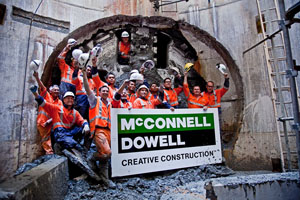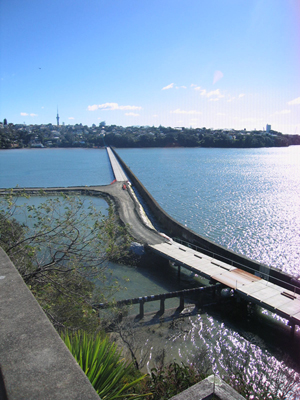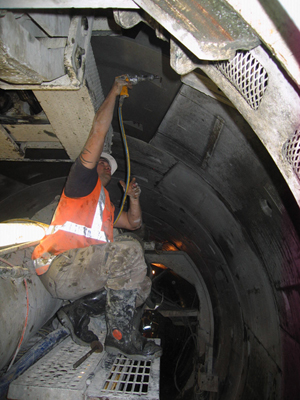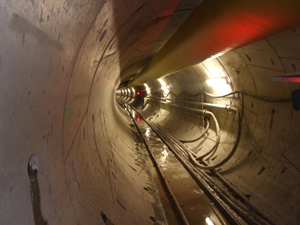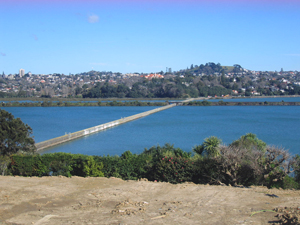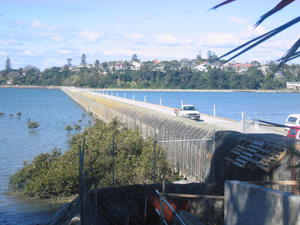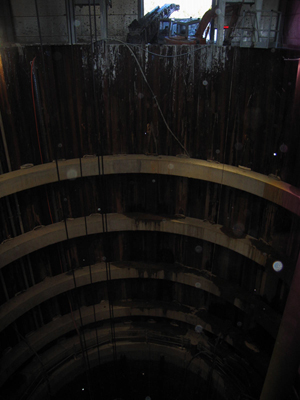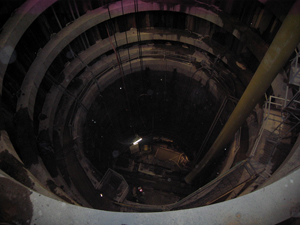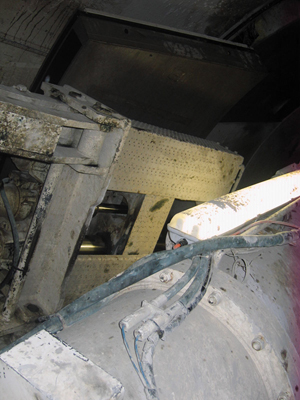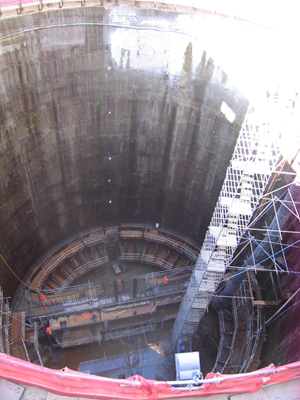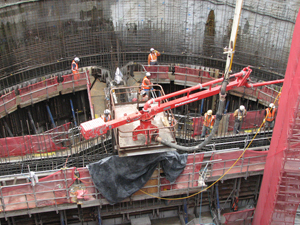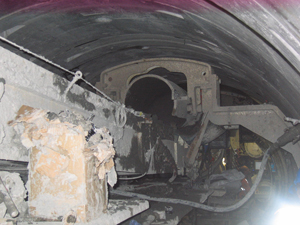McConnell Dowell securing hard-won and award winning successes in New Zealand and Australia
Feb 2009
Shani Wallis, Editor
-
The third article in our series of four McConnell Dowell site visit articles, celebrates breakthrough of the LOVAT EPBM on the Hobson Bay sewer tunnel project in Auckland, New Zealand. It follows publication of the articles describing the award winning access tunnel contract for the new Pike River coal mine development on the west coast of New Zealand’s South Island and mobilisation of the design-build contract for the Rosedale outfall project also in Auckland. The final article in the series will focus on the company's contract to build the Bogong hydropower project in the Snowy Mountains of northern Victoria, Australia. Founded in New Zealand in 1960 by Malcolm McConnell and Jim Dowell, the company of their names’ sake is fast becoming a principal player in the mid to large range tunnelling market in the Pacific Rim region. TunnelTalk visited these four current tunnelling projects last year (2008) to appreciate the scope of the undertakings and to know how each is contributing to the company’s expanding portfolio of experience. They add to an impressive list of previous tunnelling successes for the aspiring civil contractor.
Underwater works for Hobson Bay
Feb 2009
- For the Hobson Bay sewer tunnel project in Auckland, McConnell Dowell operated the first EPB TBM ever used in the particular geological conditions of New Zealand's Auckland area. The 4.35m diameter LOVAT EPBM excavated the 3km long tunnel under Hobson Bay to replace an existing 90-year old sewer that crosses the bay on concrete piles.
-

Breakthrough celebrations in early February
- The client is Watercare Services Ltd, New Zealand's largest company in the water and wastewater industry and responsible for supplying water and operating the regional wastewater network in Auckland. The Hobson Bay pipeline conveys a quarter of the Greater Auckland wastewater flows and is nearing the end of its economic life. The NZ$118 million project will provide capacity to meet projected growth in the region and virtually eliminate wastewater overflows into Hobson Bay and the Waitemata Harbour. It will also allow for the old, deteriorating and unsightly structure to be demolished and removed from the view.
- The SKM/Connell Wagner JV is responsible for all permanent works design for the owner, except for the tunnel linings, which are designed for McConnell Dowell by engineers Babendererde of Germany and the USA, in JV with Peters & Cheung of New Zealand.
- In addition to the 3km long x 3.7m i.d. tunnel and demolition of the old sewer structure, the scope of works includes excavation of three 33m-37m deep shafts of 22m, 8m and 10m i.d. each; surface reticulation/connections works; extensive concreting works in each of the shafts; and supply and installation of six 1MVA pumps in the main 22m diameter shaft.
-

Alignment under Hobson Bay
- The project’s design-bid-build contract was awarded to the Fletcher Construction/McConnell Dowell JV after presenting the best of three bidders at NZ$115 million. Within the joint venture, McConnell Dowell is responsible for tunnel excavation and lining, while Fletcher Construction is responsible for construction of the permanent shafts and pump stations and for demolition of the existing sewer.
- The contract was awarded in March 2007 and the EPB machine’s order with LOVAT was signed in the same month.
-

Access and pumping shafts
- The tunnel passes a maximum 25m below Hobson Bay. Conditions en-route comprise the laminated sandstone and siltstone of the East Coast Bays Formation (ECBF) with two paleovalleys of alluvial deposits to be encountered. The TBM was designed for working pressures of 3 bar and was fitted with a ground-conditioning system that injects foam via four injection ports on the cutting wheel and on the plenum bulkhead, as well as into the 10m long screw conveyor. The cutterhead was fitted with LOVAT picks and ripper teeth. These tools are interchangeable with LOVAT 15.5in disc cutters although discs were not required at Hobson Bay to cut through the weak to medium strength clay-rich sedimentary sandstone and siltstone of about 4 MPa USC. The cutterhead was driven to a maximum 6.4 rev/min by four 225kW, VFD electric motors and generates a maximum 3,000kNm torque at 3 rev/min.
-

Under water drive
- When TunnelTalk was on site in 2008, the machine was into the early stages of the drive. With the construction site located in a residential neighbourhood, the working shaft had to be housed within an acoustic and environmental protection building that allowed for 24h/day, 5 days/week production, working two 12hr shifts/day. Behind the cutterhead, the machine erected a precast concrete lining comprising five, steel-fibre reinforced and gasketed segments and a key in each 1.2m wide and temporarily bolted ring. The lining was designed for McConnell Dowell by Babendererde of Germany and the USA, in joint venture with Peters & Cheung of New Zealand.
- The segments were produced by Wilson Tunnelling at a casting yard established some 25km from the site and in moulds supplied by Ceresola of Switzerland. In the tunnel, segments were installed using the 360 degree mechanical erector mounted on a ring beam in the LOVAT machine and cement grout was injected through the segments to backfill the annulus.
-

Under the LOVAT TBM backup
- On a visit into the tunnel, TunnelTalk met TBM operator Simon Gibbard, recruited by McConnell Dowell in the UK after completing cable tunnels in London for contractor Morgan Est. Gibbard said he had plenty of experience working with LOVAT TBMs and was comfortable at the controls of the new Hobson Bay machine. “Yeah, the machine is performing well. We are just through the learning curve and we’re getting 12 rings on most shifts (14.4m/12hr). We’re expecting no major surprises, no dangerous gases or dramatic changes in conditions. The machine is designed for up to 3 bar working pressure, so even though we’re tunnelling under water, all should be well.”
- Operator experience was again illustrated when discussion turned to ring building. In wet conditions, ground water can run into the ring build area down the gap in the extrados of the segments on the longitudinal joints. “This gap on the outside of the gaskets is difficult for the wire brushes and grease of the tailseal to plug,” said Gibbard. “We had a similar problem on a job in the UK and we used a strip of Styrofoam glued to one face of the joint to plug the gap and close it off as a channel for water.
-

Strip of Styrafoam in the segment joint gap
- Tom Ireland, Resident Engineer on the project for Connell Wagner said: “These extrados joint gaps are obvious leakage locations. We are in fairly impermeable ground on this job, and we only had water ingress when going through a crushed zone. In soft ground with a clay/silt content, these gaps are not normally a problem. The ground closes on the shield and is generally of low permeability. In highly permeable ground, and flowing ground like fine sands, the ingress could be a lot greater. In fine sand, water through these gaps could also induce ground inflow and its consequences.”
-
Positive progress
By the end of December 2008, the 4.35m o.d. TBM was 2,500m into its 3km long drive and nearly half way out under the bay. “All was going well and progress remained steady at an average rate of 10 rings/shift or about 24m/24h production day until breakthrough into the reception shaft on 5 February,” said Rory Bishop, Project Manager for McConnell Dowell. “Our best advance was 31 rings or 37m in a day and 152m in a week. We passed under the embankment that carries the main line railway tracks across the Bay in October and stayed on track to complete the drive earlier than the mid-February drive. We will now tie in the cross passage lateral to finish our part of the contract on schedule, in July, 2009.” - Early experience with the Hobson Bay EPBM has proven the applicability of the technique in the particular geology of the Auckland region and for a number of additional water and sewer tunnelling projects needed and planned for the city and its suburbs. Application of the EPB machine on the current Rosedale Outfall project also in Auckland adds to McConnell Dowell’s experience with the technique and to its over-all background in TBM tunnelling.

